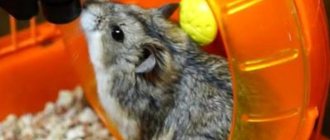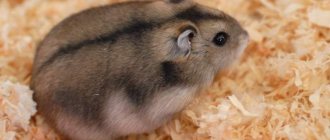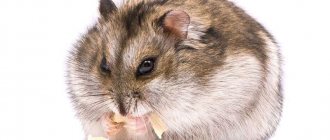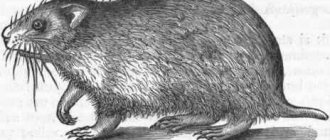Hamsters belong to the rodent subfamily of the hamster family. In total there are 6 genera, 19 species and 240 subspecies of these individuals. Habitat is Central and Eastern Europe, Asia Minor, Syria, Iran, China, Siberia, Mongolia. The animals prefer arid landscapes: fields, steppes, deserts, semi-deserts and forest-steppes. They feed on grain crops and animal food. They like to stockpile: sometimes you can find up to 80 kg of various food in a rodent’s bins. They are very fertile; a female can give birth to up to 4 litters per year. The tightly built rodents range in size from 5 to 34 cm; body color from ashy to dark brown; tummy - dark gray, brown, white; There is a black stripe along the back. Sometimes a black hamster is found in nature. It is difficult to find a rodent with this fur color. This is its value and uniqueness. What is the breed of such a hamster, read below.
Black hamsters - who are they?
It turns out that black is not the type of rodent, but the color of its fur. And such an animal is found within different breeds of the hamster family. A hamster of this color is a rare occurrence. It can only be obtained by crossing two completely black individuals. If a rodent has even a small amount of another color in its fur, then it is no longer considered black, since such a hamster can have white color only on the tips of its paws.
Let's look at the main species in which rodents of this color are found.
Variety of colors of dzungaria
Among Djungarian hamsters, black animals are rare. More often you can find a rodent with a natural color: a brown back with a dark longitudinal stripe, a light belly and white paws. This color is most common among dzungarians.
There are also unusual colors of animals:
- “Tangerine” color with red fur and a stripe along the back, like a natural color.
- Hamsters have sapphire-colored gray-blue fur.
- White color (“pearl”) is the rarest in Djungarian hamsters. White hamsters do not have a stripe on their back.
Pet hamsters
Among domesticated rodents, this coat color is most often found in Djungarian and Syrian hamsters. The black Djungarian hamster grows no more than 7 cm in length and weighs about 50 g. Because of its small stature, it is called dwarf. In nature, it lives in Western Siberia, Kazakhstan, Khakassia, prefers steppes and forest-steppes. The Syrian hamster is larger than its relative. There are individuals up to 19 cm in length and weighing up to 200 g. Prefers mountainous areas: Dagestan, Bulgaria, Turkey. Caring for such rodents is no different from caring for animals with a different coat color. For home living they require a cage or an aquarium. They are unpretentious in food: the basis of the diet is dry food, as an addition to vegetables, fruits, herbs, and always clean drinking water. It is forbidden to give sweets, flour, and fatty foods. When properly cared for, rodents can live for three to four years.
Is there a difference in care and maintenance?
In addition to the difference in appearance, Syrian and Djungarian hamsters differ in their behavior, character, and nuances of maintenance and care. At the same time, they, as representatives of the same family, have a lot in common.
Lifespan
For all hamsters, the rule usually applies: the larger the animal, the longer its lifespan. Miniature Djungarian hamsters live on average 2-2.5 years, with good care - up to 3 years. Some representatives live up to 4 years.
In Syrian hamsters, this figure is slightly higher: the average life expectancy is 3-4 years, and some rodents cross the line of 5 years. There is a known case where a long-haired Angora hamster lived to be 7 years old.
Reproduction
Even during the breeding season, Djungarian or Syrian hamsters should not be left in one cage for a long time, and after mating, it is better to separate the animals, because the female may show aggression towards her partner.
You cannot leave the male even after the offspring have appeared, since the hamster can eat the entire brood or be harmed by the mother, who is protecting her cubs.
Pregnancy in female Djungarian hamsters lasts 21-26 days. In Syrian hamsters it is shorter - approximately 16 days. The number of newborn hamsters in a Djungarian litter is from 1 to 11. Syrian hamsters can give birth to 8 to 10 babies at a time.
To prevent the new mother from eating her brood, it is necessary to provide her with food rich in calcium and protein (cottage cheese, boiled eggs and chicken meat) in advance. It is also strictly forbidden to pick up newborn babies or touch the nest. Due to the foreign smell, the female may refuse the hamsters or even eat them.
This is interesting! The only species with which Djungarian hamsters are capable of producing healthy offspring is Campbell's hamsters.
Hibernation
Many hamsters fall into hibernation, or rather sleepy torpor. At home, the process of suspended animation in pets usually starts without strict reference to the calendar. It can be triggered by a decrease in room temperature to +10° Celsius (the lower acceptable limit for normal animal activity is +15°C), insufficient lighting, poor nutrition, fear and severe stress.
Owners of furry pets often have completely opposite opinions about the benefits and necessity of hibernation for pet hamsters:
- You should not wake your pet so as not to disrupt the natural cycle of life. Actions: it is necessary to provide the animal with comfortable conditions for sleeping (insulate the house, add soft bedding and carefully move the hamster into this nest, make sure that there is food in the feeder when it comes out of hibernation).
- Hibernation is an unnatural state for a pet hamster; it disrupts the established rhythm of life. Actions: eliminate errors in care that could cause hibernation, carefully warm the pet in your hands. It is strictly forbidden to use heating devices!
Important! You need to wake up the hamster if it has not had time to gain fat. The lack of vital reserves in the form of fat will lead to dehydration and exhaustion of the body.
House
Both Djungarian and Syrian hamsters need a spacious cage. The minimum parameters of the bottom in it are 15x30 cm, regardless of whether there are additional floors in the cage.
Dwarf hamsters are extremely active and mobile, so they need a lot of free space. The home must be equipped with a good network of tunnels and passages, as well as a running wheel. To prevent the hamster from running away from the house, it is important to prepare a cage with a fine mesh.
Syrian hamsters also show noticeable activity, especially in the dark, but in their case free space is required for another reason - due to their rather large body size.
The Syrian hamster is a large, strong and smart animal. It can easily open a simple door latch or squeeze through bars. Therefore, to keep it, it is important to choose a high-quality cage with a plastic tray, a reliable lock and a metal grill.
Due to lack of exercise, both breeds are prone to the following problems:
- development of obesity;
- heart diseases;
- decreased immunity.
A good incentive for active movement will be tunnels, labyrinths, passages and a large wheel (at least 20 cm in diameter) in a cage.
Hamsters are prone to colds, so the house must be reliably protected from drafts. It is also not recommended to bathe your pets; it is better to put a sand bath in the cage.
Diseases
If the hamster has no appetite, bowel movements are abnormal, the animal is lethargic or overly active, shows unmotivated aggression, sneezes or sniffles, it should be shown to a veterinarian.
A ratologist deals with rodents, but this is a rather rare profession, so if necessary, you can go to a regular veterinary clinic.
Main diseases of hamsters:
- cold;
- flu;
- pneumonia;
- cystitis;
- proliferative ileitis, “wet tail”;
- stomach upset;
- conjunctivitis;
- lichen;
- mites;
- abscesses;
- lymphocytic choriomeningitis.
Despite this list, hamsters are usually healthy and cheerful animals. Problems arise when the animal is not eating properly, is not provided with good care, or is an elderly pet.
Djungarian hamsters are prone to developing diabetes, so you need to carefully select food for them. Unlike Syrians, Djungarians often live in groups, which increases the rate of spread of infection among all inhabitants of the cage.
Nutrition
The simplest and safest feeding option is ready-made mixtures for hamsters. You can diversify your rodent's diet with the following products:
- greens and dandelions;
- boiled chicken meat;
- egg;
- cottage cheese;
- kefir;
- porridge (cooked with water and without salt);
- flax seeds;
- cereals (oats, rye, wheat and millet);
- melon, sunflower or pumpkin seeds;
- sesame;
- dried fruits and berries.
The list of prohibited foods includes fruit seeds and almonds, which are deadly for hamsters (the ban does not apply to other types of nuts), sorrel, cabbage, potatoes, citrus fruits, watermelons (and any melons in general).
Owners of Djungarian hamsters need to ensure that their food does not contain too much sugar. There should always be clean and fresh water in the drinking bowl, which is changed daily.
Habits and character
Sociable Djungarian hamsters get along well in the same cage with their brothers. Syrian hamsters absolutely cannot stand strangers in the house and always live alone. If you put another pet in the cage, they will definitely fight with each other.
Good-natured fatties
However, in relation to humans, golden hamsters show themselves as friendly and sociable companions, willing to make contact and get along well with children. They are easy to train if you start training at an early age (no later than 1.5–2 months).
After establishing contact, Syrian hamsters quickly master simple tricks, get used to the tray, love to sit on your shoulder and respond to a nickname.
Typically, golden hamsters do not show aggression towards humans; they can bite only if handled roughly and carelessly: if they are disturbed while resting, grabbed sharply, turned upside down, if their hands smell of delicious food, or if the hamster is sick.
In general, Syrian hamsters are clean and take good care of their coats. Only females emit a specific odor during estrus.
Independent babes
The dzhungarik has a more independent character, which manifests itself even in young individuals. They are less responsive and difficult to train. These kids are quite content with constant fussing and communicating with other pets, so they do not strive for socialization.
Djungarian hamsters worry less about body cleanliness than Syrian hamsters. In addition, the glands that are located on their abdomen emit a strong odor. In males it is more pronounced than in females.
forest hamster
The black forest hamster is similar in appearance to its relatives, but is larger in size. It grows up to 35 cm in length and gains up to one kilogram in weight. The habitat is extensive: from China to Europe. The wild hamster is very aggressive and poses a threat to humans and domestic animals. Only a dog can cope with it; a cat is too small to emerge victorious from the fight. A rodent bite leaves lacerations, but the most unpleasant thing is that it can lead to infection with various types of infections with a fatal outcome. The animal has incredible vitality. It is not afraid of frost, as it has a thick undercoat, and digs deep holes for wintering. Leads a nocturnal lifestyle. Very gluttonous and thrifty. It feeds on corn, peas, potatoes, pumpkin, onions, seeds and rhizomes. He prefers to settle close to people so that he can eat vegetables and herbs planted in gardens. The people gave the hamster the name karbysh. The invasion of such rodents threatens the complete destruction of plantings. This is the scourge of gardeners and gardeners.
Where does the wild karbysh hamster live?
This animal is found in forest and mixed-grass steppes. In Russia, the border of its habitat stretches from the city of Smolensk to the northern part of the Perm Territory. Then it stretches through Yekaterinburg to Krasnoyarsk, crossing the Ob and Irtysh rivers.
In the south, the border of the habitat of the carbysh stretches along the coast of the Azov and Black Seas, then moves to the western Ciscaucasia, crosses the Volga River and goes to Kazakhstan. The region also covers the Tien Shan (eastern and northern regions), the Alakol and Zaisan basins, and closes on the right bank of the Yenisei River, before passing along the border of western Altai.
Common hamster
It has another name - field hamster. Among rodents of this species, there are often completely black specimens, they are called melanites, or black specimens with white paws. This hamster lives mainly in Europe. A fairly large individual: it grows up to 34 cm and weighs more than 500 g. The muzzle is long, the ears are round and small. The foot is wide, the claws are large and sharp. They live in burrows that reach a depth of up to 2 m. In winter they hibernate, waking up once every ten days to feed on supplies made in the summer. They are very clean; the latrine in the hole is kept separate from the main place of residence. They prefer to eat grain crops, seeds, rhizomes, insects, carrion, and sometimes attack mice. The breeding season begins in April. The female can give birth to up to 18 cubs, but she feeds only eight, according to the number of nipples on her stomach, and eats the rest. In case of danger, hamsters hide in minks. They show aggression only towards enemies or their relatives.
Where to place a pet
Considering the fact that the size of rodents varies depending on the breed, houses for them are selected accordingly:
- The Djungarian black hamster needs a cage measuring 100 by 40 centimeters.
- For Syrians, dwellings with dimensions of 40x30x30cm are suitable.
Care and maintenance must be timely. Otherwise, the unpleasant smell will spread throughout the entire apartment. In addition, dirt and unsanitary conditions cause diseases and inflammatory processes in the furry body. It is recommended to choose a plastic tray because it is easier to clean and does not absorb odors.
The dwelling is filled with mineral stone and always with twigs, on which it grinds down the teeth. For normal living conditions, the cage must be equipped with sports equipment, because black hamsters are prone to obesity:
- Running wheel.
- Tunnels or snags for climbing.
- Hammocks.
Animals are nocturnal, so it is better to keep a cage or aquarium out of the bedroom so that they do not interfere with the rest of people during activity in the dark.
Diet
Food for black hamsters should be rich in proteins of animal and plant origin. A balanced diet is the key to your pet’s health. Special mixtures for rodents, which are sold in any pet stores, are suitable. They are inexpensive. Additionally, veterinarians recommend giving seeds of cereals and insects. Several times a week, fluffies need to be given dairy products, pieces of eggs and chicken.
The animals are fed twice a day. Make sure that the animal does not carry food “in reserve” into the house, because expired food can cause serious poisoning. The rodent lives in wild conditions with almost no water, so it has adapted to be content with moisture from plants. Constantly replenish your supply of cabbage and lettuce.
White-footed hamster
White-footed hamsters are common in Canada, the USA, Mexico, and Panama. They prefer mountainous, forest, desert and arid areas. The length ranges from 10 to 21 cm. Despite the name, there are hamsters that are completely black. They are nocturnal and live in small groups. But they don’t dig holes, but build nests from sticks and straw, or take refuge in gorges. They feed on nuts, seeds, fruits, vegetables, insects, and carrion. In nature, their life cycle is two years, but with home care they can live up to six years.
How long does a black hamster live?
The lifespan of a black hamster depends on the breed and conditions of detention.
The average life expectancy in the wild is two years. It is capable of obtaining food for itself and reliably hiding in burrows; however, hamsters often become prey to predatory animals.
If an animal lives in captivity, it is provided with conditions for active pastime and is provided with high-quality food, and will live for 4 years.
On a note. To prolong the pet's life, it is protected from stress and its health is closely monitored.
Campbell's hamster
These are dwarf hamsters. Outwardly they are very similar to their relatives, the Djungarians. They live in Mongolia, China, Russia, Kazakhstan. In nature, Campbell's hamsters do not exist with a black color; only domesticated, artificially bred rodents have fur of this color. They have an independent character and lead a solitary lifestyle. Of all the pet hamsters, they are the worst to train. It happens that throughout their life they bite their owner’s fingers. Due to their small stature, only aquariums are suitable for them as housing; they escape from cages. Care, maintenance and nutrition are the same as for other domestic rodents.
Thus, we found out that a black hamster is not some special individual, but the color of the fur of a hamster belonging to any species.
Conservation status of karbysh
The wild hamster is protected in the following countries:
- Poland;
- Germany;
- Netherlands;
- France;
- Belgium;
- Belarus;
- Ukraine.
INTERESTING! Over the past 20 years, the number of carbish has decreased. In Russia, the rodent is protected only in 5 regions. However, in Siberia and Kazakhstan the number remains the same.
Origin of the species and description
Photo: Syrian hamster
The Syrian hamster is a chordate animal. They are classified into the class of mammals, the order Rodents, the family Hamsters, the genus Medium hamsters, and the species Syrian hamsters. Initially, the name golden hamster was assigned to them thanks to zoologist Georg Robert Waterhouse. On the recommendation of Charles Darwin, he compiled a list of animals that arrived from the expedition on the Beagle. Among the diversity of representatives of the animal world, there was the only representative of this breed.
Video: Syrian hamster
This species of animal was first described by the English scientist, zoologist and researcher George Robert Waterhouse in 1839. The scientist mistakenly considered it an extinct species. This assumption was refuted in 1930, when another scientist Israel Aharoni, during his expedition, discovered a Syrian hamster - it was a pregnant female. The scientist transported this hamster to the University of Judea, where the female safely gave birth to 11 small hamsters. Subsequently, of the entire brood, only three males and the female who gave birth to them remained alive.
Scientists tried in vain to find other individuals of this species in natural conditions. However, they never managed to do this. Then Akhoroni came up with the idea of crossing a female Syrian hamster with a male of a related species. This couple became the progenitors of a new species. Around 1939-40, the resulting offspring were transported to the United States of America. After another 1.5-2 years, scientists finally came to the conclusion that the Central Asian hamsters had become extinct, and there were no more representatives of this species in natural conditions.
In the process of studying Syrian hamsters, it was found that they have a dental structure similar to that of humans, and therefore they were used in laboratory conditions to study dental diseases. To date, scientists have not been able to answer the question of what caused the extermination of this species of animals.
Rules for caring for a Syrian hamster
Syrian hamsters are easy to care for. For a pet to live comfortably, it is necessary to keep the cage clean and provide regular and balanced nutrition.
Walks and games
If the animal's cage is equipped with everything necessary, then it does not require additional walks.
If you want to let your pet roam around the apartment, purchase a special ball. The hamster will not be able to escape from it and will always be in sight.
What not to do
You should not let your hamster out on the street: in the grass you will quickly lose sight of him.
Protect the animal from falling from heights. The bones of his skeleton are fragile, and any fall can end sadly, even fatally. Be careful when handling your pet. Don't leave him outside his cage unattended.
What living conditions does a hamster require?
It is best to house your hamster in a spacious wire cage, Choosing a Dwarf Hamster Cage. The minimum floor area is 60 × 30 cm. A plastic tray is considered a good option. But grated flooring is not suitable: your pet will easily injure its paws on it. The door of the home must close tightly. The distance between the rods is no more than 5 mm. Otherwise, the rodent may escape.
If you choose a multi-level design, pay attention to the height of the floors. The lower they are, the better. Then, when falling, the animal will not be seriously injured.
A pet store may offer you a plastic cage with pipes. Keep in mind: it will not provide adequate ventilation. In addition, it will be difficult to clean.
Hamsters are susceptible to cold and heat. They feel best at a temperature of 18–21 °C The ideal home for your hamster. Therefore, the cage is usually placed away from drafts, radiators and direct sunlight. If the room is too cold, the animal may hibernate. Loud sounds and vibrations cause stress in rodents. Therefore, it is worth finding a calm and quiet place for the house. There should be no TV or music system nearby.
Be sure to place a ceramic bowl inside the cage How to Care for Your Pet Hamster, and pour water into the nipple drinker.
A large layer of bedding should be laid on the pallet of the dwelling. Animals love to rummage in it. If you want to go with wood How to Care for Your Pet Hamster litter, choose aspen. Cedar and pine irritate the respiratory tract of hamsters.
The cage should also have shelter. The pet will rest there. If desired, you can buy a wooden or plastic house. Some owners use cardboard boxes. They wear out quickly, but are easy to replace.
Running wheel without cross supports. Photo: PetroP/Depositphotos
A hamster definitely needs a large running wheel. Try to find something that attaches to the cage. Typically, such models do not have transverse supports on which the animal can damage its paws. If you are a light sleeper, choose a quiet design.
To grind down the teeth that hamsters constantly grow, you will need wooden toys from Pet Hamster Toys. But some owners simply give their pets toilet paper or towel rolls instead.
What is the character of hamsters?
Rodents are active and curious Providing a Home for a Hamster. Animals are interesting to watch when they play in a cage. If a pet has been accustomed to communicating with a person since childhood, it can calmly sit in your arms. Hamsters rarely bite All About Syrian Hamsters: mainly when they are frightened by a sudden movement. Before communicating, for example, with Syriac, it is recommended to wash your hands. He has poor eyesight, so he relies on smell and touch. If the owner's fingers smell of food, the animal can taste them.
It is not worth keeping individuals in pairs. Even when they live together from an early age, conflicts can arise over time.
If you are still going to buy several animals, it is better to place them in different cages.
Keep in mind that rodents are nocturnal. They sleep during the day, so it is better to play with them in the evening. If you decide to wake up your All About Syrian Hamsters pet, do it very carefully. Talk to him in a gentle voice and lightly rustle the bedding in the cage.
Djungarian hamster: features of communication with the animal
The Djungarian hamster, the photo of which is presented below, is a cute and harmless animal. But this little family member also has his own character and behavior. Here's what you need to know when establishing communication with Djungarians:
Relationships with relatives
Djungarian hamsters live alone in nature. If you want to get offspring, then take two rodents from the same litter. Even in this case, they may not get along with each other, and then battles are guaranteed. Dzungariks defend their territory aggressively and assertively, so they fight until there is blood. Keep this in mind if you decide to add a Djungarian or Syrian neighbor to your rodent.
If the female is expecting offspring, move the male to a separate “apartment”. Pregnancy is stressful for both parents, so one of them will definitely eat the offspring.
Photo: pixabay.com: UGC
Djungarian hamster in the same territory with dogs and cats
The presence of a larger predator next to the cage will in no way disrupt the peaceful course of life of the rodent. A smart dwarf will quickly understand that the bars of his cage protect him from the claws and teeth of a cat or dog and will stop paying attention to their attempts to pull him out of the cage. He will also run quickly, rummage through sawdust, and carry grains. Sometimes it will do this on purpose to tease predators.
The danger lies in the hamster's curiosity and energy, which force him to leave the cage at the earliest opportunity. Then his life is in danger. So remember to close the cage, play and train your hamster, making sure there are no other animals in the room.
Communication between a dzhungarik and a person
The smart and funny hamster is easy to tame. He will happily leave the cage to run and frolic in a small space. Rodents react well to children, do not bite, but always try to escape. Since they are fragile and delicate, during play, make sure that the hamster does not get injured by falling from a height or getting stuck between two objects.
Photo: pixabay.com: UGC
To minimize the stress of taming a dwarf:
- In the first week of life in a new place, allow the rodent to adapt. Place the cage so that he can observe people's movements, but so that the noise is minimal.
- Do not disturb the animal during daytime sleep.
- Don't "rob" his bins.
- In the first weeks, watch his games and talk to the animal so that he gets used to the human voice and his presence.
- Lure him out of the house by offering him treats - nuts or dried fruits. After a while he will get used to eating from his hands and sitting on his palm.
Djungarian hamsters are ideal pets for small children. Children 3–4 years old enjoy caring for these animals: feeding them and helping with cleaning. Unpretentiousness and ease of care, lively character and comic actions make the Djungarians family favorites.
Main diseases of Syrians and their prevention
Syrian hamsters very rarely get sick. To minimize the risk of disease, you need to buy them from a registered breeder and keep them properly. Regular checks with a veterinarian are sufficient prevention for them. And yet, Syrians can sometimes get sick.
Let us highlight the main signs of deteriorating health in a hamster. If you notice them, take your pet to the veterinarian for an examination. Home treatment is not the best option.
So, the signs you should pay attention to:
- lack of appetite, strong pickiness in choosing foods;
- increased secretion of saliva, wet fur from below the muzzle;
- digestive disorders: liquid, dry or hard feces;
- tearfulness or purulent discharge covering the eyelids;
- respiratory tract diseases: wheezing, wheezing;
- deterioration of the coat: hair loss, wounds, scratching;
- reluctance to be physically active
- trembling, convulsions, loss of coordination;
- unnatural formations on the hamster's body.











